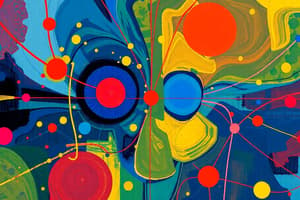Podcast
Questions and Answers
What is sensation?
What is sensation?
Information from the environment via receptor cells.
What is perception?
What is perception?
The interpretation of sensory information.
What is the role of sensory receptor cells?
What is the role of sensory receptor cells?
- They convert sensory energy into neural impulses. (correct)
- They interpret sensory information.
- They do not play a significant role.
- They are responsible for perception.
Bottom-up processing refers to concept-driven processing.
Bottom-up processing refers to concept-driven processing.
What is transduction?
What is transduction?
What influences top-down processing?
What influences top-down processing?
What is the word superiority effect?
What is the word superiority effect?
The _______ illusion shows how depth cues can affect size perception.
The _______ illusion shows how depth cues can affect size perception.
The Müller-Lyer illusion is primarily experienced by all cultures equally.
The Müller-Lyer illusion is primarily experienced by all cultures equally.
Match the following concepts with their descriptions:
Match the following concepts with their descriptions:
What phenomenon demonstrates the integration of multiple sensations?
What phenomenon demonstrates the integration of multiple sensations?
Flashcards are hidden until you start studying
Study Notes
Perception
- Perception is the interpretation of sensory information, influenced by experience, prior knowledge, expectations, and context.
- It is a top-down process, where information from the environment is combined with existing knowledge to create meaning.
Sensation
- Sensation is the process of receiving information from the environment via receptor cells, which transduce sensory information and send it to the brain.
- It's a bottom-up process, driven by the sensory stimuli received from the environment.
Sensory Receptor Cells
- Specialized cells that transduce sensory information.
- Tell the brain about the quality (e.g., sweet, sour, bitter, salty) and intensity (brightness, loudness, amount of sweetness) of stimuli.
Transduction
- The process of converting environmental energy into neural impulses, which the brain can understand.
- Responsible for bridging the gap between sensation and perception.
Word Superiority Effect
- We are faster and more accurate at identifying letters when they are part of a word.
- Demonstrates the power of top-down processing and the influence of context on perception.
Depth Cues
- Provide information about the distance and relative size of objects in our environment.
- Help us perceive depth and interpret the three-dimensional world.
Perceptual Constancy
- Our perception of objects as unchanging in color, shape, or size despite changes in illumination and retinal images.
- Examples include size constancy, where we perceive an object as the same size regardless of its distance.
Illusions
- Perceptions that do not accurately reflect reality.
- Demonstrate how our perception can be influenced by factors like depth cues and our pre-existing knowledge.
Ponzo Illusion
- An illusion of size perception, where two objects of equal size appear different sizes due to converging lines.
- Illustrates how depth cues can influence our judgments about size.
Muller-Lyer Illusion
- An illusion of line length, where two lines of equal length appear different sizes due to the presence of arrowheads.
- Reveals how cultural influences can affect perception.
Sensory Integration
- The process of combining information from multiple senses to create a single, unified perception.
- Creates a richer and more meaningful experience of the world.
McGurk Effect
- An illusion where auditory information is altered by visual information, leading to the perception of a different sound than what is actually being played.
- Demonstrates the powerful influence of visual information on auditory perception.
Gestalt Psychology
- Stresses that the perception of the whole is greater than the sum of its parts.
- Provides a framework for understanding how we perceive patterns and organize visual information.
Gestalt Principles
- Principles that describe how we organize visual information, such as:
- Proximity: We group objects that are close together.
- Similarity: We group objects that are similar in appearance.
Studying That Suits You
Use AI to generate personalized quizzes and flashcards to suit your learning preferences.



